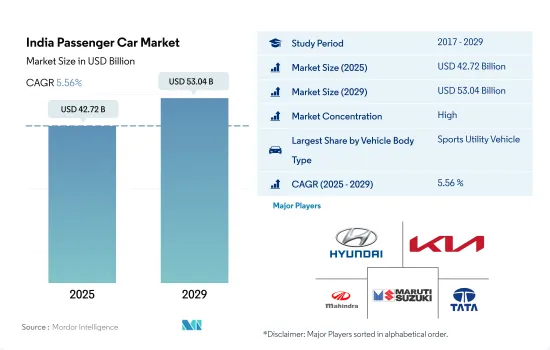
|
시장보고서
상품코드
1693629
인도의 승용차 시장 : 시장 점유율 분석, 산업 동향 및 통계, 성장 예측(2025-2030년)India Passenger Car - Market Share Analysis, Industry Trends & Statistics, Growth Forecasts (2025 - 2030) |
||||||
인도의 승용차 시장 규모는 2025년에 427억 2,000만 달러로 추정되고, 2029년에는 530억 4,000만 달러에 이를것으로 예측되며, 예측 기간(2025-2029년)의 CAGR은 5.56%를 나타낼 것으로 예측됩니다.

인도의 역동적인 소비자 수요와 도시 환경에 맞춰 승용차의 커스터마이징과 혁신이 증가하고 있음을 나타냅니다.
- 해치백, 세단, SUV(스포츠 유틸리티 차량), MPV(다목적 차량)로 분류되는 인도의 승용차 시장은 광범위한 사회경제적 트렌드와 라이프스타일에 대한 열망을 반영하여 인도 소비자의 다양한 선호도와 니즈에 대한 인사이트를 제공합니다. 이러한 세분화는 시장의 복잡성과 각 차량 카테고리의 성장을 촉진하는 동인을 강조합니다.
- 인도에서 해치백의 인기는 크기가 작아 혼잡한 도심 도로에서 민첩하게 움직일 수 있을 뿐만 아니라 소유 및 유지 비용이 상대적으로 저렴하다는 점에서도 기인합니다.
- 경쟁이 심화되고 있음에도 불구하고 해치백은 시장에서 상당한 점유율을 유지하고 있습니다. 다른 부문와의 경쟁 심화에도 불구하고 해치백은 다목적성과 경제성으로 인해 상당한 시장 점유율을 유지하고 있습니다.
인도의 승용차 시장 동향
정부의 노력과 엄격한 규제가 인도 전기자동차 시장의 급성장을 뒷받침
- 인도의 전기차(EV) 시장은 성장기에 있으며, 정부가 환경오염 방지를 위한 전략을 적극적으로 수립하고 있습니다. 2015년에 시작된 페임 인디아 제도는 차량 전기화를 촉진하는 데 중추적인 역할을 해왔습니다.
- 인도 전역의 주 정부는 내연기관(ICE) 버스에서 전기 버스로 전환하기 위해 점점 더 많은 전기 버스를 차량에 도입하고 있습니다. 이러한 움직임은 운영 비용을 절감할 뿐만 아니라 탄소 배출을 억제하고 대기 질을 개선하는 효과도 있습니다. 주목할 만한 움직임으로 델리 정부는 2021년 3월에 300대의 새로운 저상 전기(AC) 버스 조달을 승인했으며, 이 중 100대는 2022년 1월에 도로에 투입될 예정입니다.
- 최근 인도 정부의 엄격한 규범 도입으로 전기자동차에 대한 수요가 급증하고 있습니다. 2021년 8월, 인도 정부는 연식에 관계없이 공해를 유발하고 부적합한 차량을 단계적으로 퇴출하는 것을 목표로 하는 차량 폐기 정책을 발표했습니다.
인도의 승용차 산업 개요
인도의 승용차 시장은 상위 5개 기업이 91.48%를 점유하는 등 상당히 통합되어 있습니다. 이 시장의 주요 업체는 Hyundai Motor India Limited, Kia Corporation, Mahindra & Mahindra Limited, Maruti Suzuki India Limited, Tata Motors Limited(알파벳 순 정렬)입니다.
기타 혜택
- 엑셀 형식 시장 예측(ME) 시트
- 3개월의 애널리스트 지원
목차
제1장 주요 요약과 주요 조사 결과
제2장 보고서 제안
제3장 소개
- 조사의 전제조건과 시장 정의
- 조사 범위
- 조사 방법
제4장 주요 산업 동향
- 인구
- 1인당 GDP
- 차량 구매를 위한 소비자 지출(CVP)
- 인플레이션율
- 자동차 대출 금리
- 공유 차량 서비스
- 전기화의 영향
- EV 충전소
- 배터리 팩 가격
- Xev 신모델 발표
- 연료 가격
- OEM 생산 통계
- 규제 프레임워크
- 밸류체인과 유통채널 분석
제5장 시장 세분화
- 차량 구성
- 승용차
- 해치백
- 다목적 차량
- 세단
- SUV
- 승용차
- 추진 부문
- 하이브리드 자동차와 전기자동차
- 연료 카테고리별
- BEV
- FCEV
- HEV
- PHEV
- ICE
- 연료 카테고리별
- 천연가스
- 디젤
- 가솔린
- LPG
- 하이브리드 자동차와 전기자동차
제6장 경쟁 구도
- 주요 전략 동향
- 시장 점유율 분석
- 기업 상황
- 기업 프로파일
- Honda Cars India Limited
- Hyundai India Limited
- Kia Corporation
- Mahindra & Mahindra Limited
- Maruti Suzuki India Limited
- MG Motor India Private Limited
- Nissan Motor India Pvt. Ltd.
- Renault India Pvt. Ltd.
- Tata Motors Limited
- Toyota Kirloskar Motor Pvt. Ltd.
- Volkswagen AG
- Skoda Auto Volkswagen India Pvt. Ltd.
제7장 CEO에 대한 주요 전략적 질문
제8장 부록
- 세계 개요
- 개요
- Five Forces 분석 프레임워크
- 세계의 밸류체인 분석
- 시장 역학(DROs)
- 출처 및 참고문헌
- 도표 일람
- 주요 인사이트
- 데이터 팩
- 용어집
The India Passenger Car Market size is estimated at 42.72 billion USD in 2025, and is expected to reach 53.04 billion USD by 2029, growing at a CAGR of 5.56% during the forecast period (2025-2029).

Indicates the growing customization and innovation in passenger cars, adapting to India's dynamic consumer demands and urban landscape
- The Indian passenger car market, categorized into hatchbacks, sedans, SUVs (sport utility vehicles), and MPVs (multi-purpose vehicles), offers insights into the diverse preferences and needs of Indian consumers, reflecting broader socio-economic trends and lifestyle aspirations. This segmentation underscores the market's intricacy and the drivers fueling growth in each vehicle category. Hatchbacks, historically pivotal in the Indian passenger car market, resonate with first-time buyers, middle-class families, and urban dwellers seeking practical, affordable, and efficient mobility solutions.
- Hatchbacks' popularity in India stems from their compact size, making them agile on congested city streets, as well as their relatively lower ownership and maintenance costs. With a plethora of manufacturers offering hatchbacks, consumers enjoy a wide array of choices in terms of pricing, features, and performance.
- Despite the intensifying competition, hatchbacks retain a substantial share of the market. Despite the growing competition from other segments, hatchbacks hold a significant market share due to their versatility and economic viability. SUVs have recently witnessed a meteoric rise in popularity, becoming the fastest-growing segment in the Indian passenger car market. The shift toward SUVs is driven by a combination of factors, including a growing preference for higher seating positions, more spacious interiors, and perceived safety advantages. Moreover, the broad spectrum of SUVs available, from compact and subcompact models to mid-size and full-size options, ensures an SUV to suit almost every budget and lifestyle requirement.
India Passenger Car Market Trends
Government initiatives and stringent norms drive rapid growth in the electric vehicle market in India
- India's electric vehicle (EV) market is in a growth phase, with the government actively formulating strategies to combat pollution. The Fame India scheme, launched in 2015, has played a pivotal role in driving vehicle electrification. Building on its success, Fame Phase 2, active till April 2022, further bolstered EV sales, especially in 2021, with the government offering subsidies like INR 10,000 grants for electric cars with battery capacities up to 15 kWh.
- State governments across India are increasingly incorporating electric buses into their fleets, aiming to transition from internal combustion engine (ICE) buses. This move not only cuts operational costs but also curbs carbon emissions and improves air quality. In a notable move, the Delhi government greenlit the procurement of 300 new low-floor electric (AC) buses in March 2021, with 100 of them hitting the roads in January 2022. These initiatives contributed to a significant 62.58% surge in demand for electric commercial vehicles in India in 2022 over 2021.
- The demand for electric cars has surged in recent times, driven by the government's introduction of stringent norms. In August 2021, the Indian government unveiled the Vehicle Scrappage Policy, targeting the phasing out of polluting and unfit vehicles, irrespective of their age. This policy, set to be implemented by 2024, is steering consumers toward electric cars. Additionally, the government has set an ambitious target of having 30% of all cars in India electrified by 2030. These initiatives are poised to propel electric car sales during the 2024-2030 period in India.
India Passenger Car Industry Overview
The India Passenger Car Market is fairly consolidated, with the top five companies occupying 91.48%. The major players in this market are Hyundai Motor India Limited, Kia Corporation, Mahindra & Mahindra Limited, Maruti Suzuki India Limited and Tata Motors Limited (sorted alphabetically).
Additional Benefits:
- The market estimate (ME) sheet in Excel format
- 3 months of analyst support
TABLE OF CONTENTS
1 EXECUTIVE SUMMARY & KEY FINDINGS
2 REPORT OFFERS
3 INTRODUCTION
- 3.1 Study Assumptions & Market Definition
- 3.2 Scope of the Study
- 3.3 Research Methodology
4 KEY INDUSTRY TRENDS
- 4.1 Population
- 4.2 GDP Per Capita
- 4.3 Consumer Spending For Vehicle Purchase (cvp)
- 4.4 Inflation
- 4.5 Interest Rate For Auto Loans
- 4.6 Shared Rides
- 4.7 Impact Of Electrification
- 4.8 EV Charging Station
- 4.9 Battery Pack Price
- 4.10 New Xev Models Announced
- 4.11 Used Car Sales
- 4.12 Fuel Price
- 4.13 Oem-wise Production Statistics
- 4.14 Regulatory Framework
- 4.15 Value Chain & Distribution Channel Analysis
5 MARKET SEGMENTATION (includes market size in Value in USD and Volume, Forecasts up to 2029 and analysis of growth prospects)
- 5.1 Vehicle Configuration
- 5.1.1 Passenger Cars
- 5.1.1.1 Hatchback
- 5.1.1.2 Multi-purpose Vehicle
- 5.1.1.3 Sedan
- 5.1.1.4 Sports Utility Vehicle
- 5.1.1 Passenger Cars
- 5.2 Propulsion Type
- 5.2.1 Hybrid and Electric Vehicles
- 5.2.1.1 By Fuel Category
- 5.2.1.1.1 BEV
- 5.2.1.1.2 FCEV
- 5.2.1.1.3 HEV
- 5.2.1.1.4 PHEV
- 5.2.2 ICE
- 5.2.2.1 By Fuel Category
- 5.2.2.1.1 CNG
- 5.2.2.1.2 Diesel
- 5.2.2.1.3 Gasoline
- 5.2.2.1.4 LPG
- 5.2.1 Hybrid and Electric Vehicles
6 COMPETITIVE LANDSCAPE
- 6.1 Key Strategic Moves
- 6.2 Market Share Analysis
- 6.3 Company Landscape
- 6.4 Company Profiles
- 6.4.1 Honda Cars India Limited
- 6.4.2 Hyundai Motor India Limited
- 6.4.3 Kia Corporation
- 6.4.4 Mahindra & Mahindra Limited
- 6.4.5 Maruti Suzuki India Limited
- 6.4.6 MG Motor India Private Limited
- 6.4.7 Nissan Motor India Pvt. Ltd.
- 6.4.8 Renault India Pvt. Ltd.
- 6.4.9 Tata Motors Limited
- 6.4.10 Toyota Kirloskar Motor Pvt. Ltd.
- 6.4.11 Volkswagen AG
- 6.4.12 Skoda Auto Volkswagen India Pvt. Ltd.
7 KEY STRATEGIC QUESTIONS FOR VEHICLES CEOS
8 APPENDIX
- 8.1 Global Overview
- 8.1.1 Overview
- 8.1.2 Porter's Five Forces Framework
- 8.1.3 Global Value Chain Analysis
- 8.1.4 Market Dynamics (DROs)
- 8.2 Sources & References
- 8.3 List of Tables & Figures
- 8.4 Primary Insights
- 8.5 Data Pack
- 8.6 Glossary of Terms



















